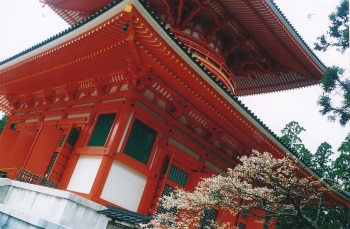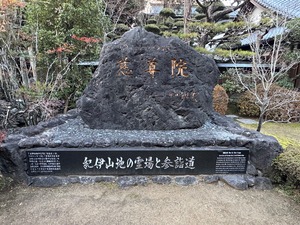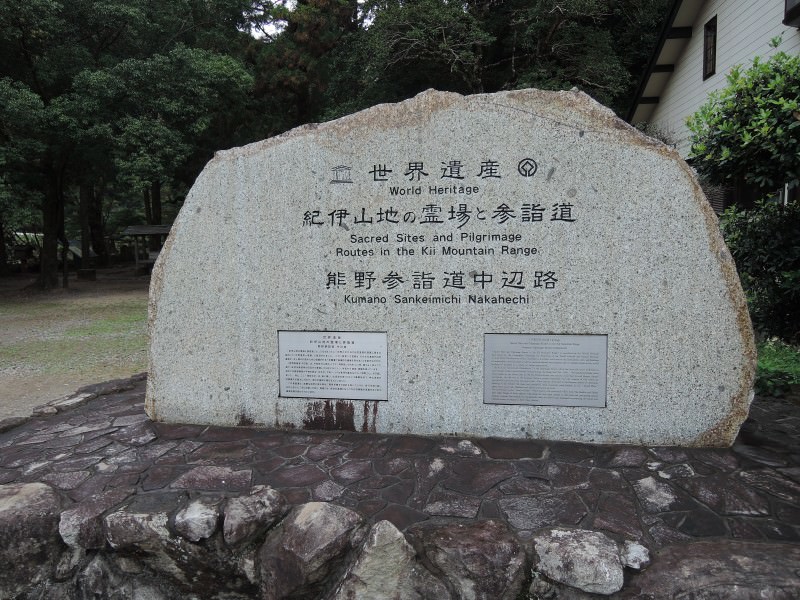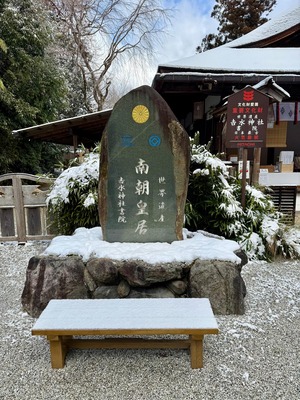Kii Mountain Range

The Sacred Sites and Pilgrimage Routes in the Kii Mountain Range are testimony to the indigenous Shinto belief and its fusion into Shinto-Buddhism.
These three sacred sites with Shinto shrines and Buddhist temples lie in the forests of the sacred Kii Mountains. They have attracted pilgrims since the 11th century. Their architecture has had a profound influence on the building of temples and shrines elsewhere in Japan.
Community Perspective: Koyasan is the most visited component, and one can easily arrange a temple stay here. John went to all three main sites, and Frederik, Hubert and Nan ‘did’ Yoshino which lies close to Nara.

Map of Kii Mountain Range
Community Reviews
Hubert

To visit the Kii Mountain WHS, Yoshino is the closest option from Nara. I visited Yoshino in September 2019 and spent a day and a half there. Yoshino is the starting point of the Ōmine Okugakemichi pilgrimage route that ends at the Kumano Hongū Taisha Shrine. I actually planned to hike the first part of the trail up to the Ōminesan-ji Temple and wanted to stay the night there. That would have been a hike of 16 km, from 500 m sea level over two peaks up to 1700 m, exhausting but doable in one day. However, I was a week too late, the temple is only open in the warm months and was already closed at the end of September. So, I did a shorter hike to Shisuniwa peak, about halfway, and stayed in Yoshino.
Yoshino, or more precisely the mountain region Yoshino-yama, is an important centre of Shugendō, a syncretistic belief, whose practitioners seek spiritual power through ascetic practices in the sacred mountains. Asceticism and spirutuality are certainly not the first associations that arise when you step out of the cable car at the mountain station. The street through the village is lined with restaurants and shops. However, in late September, only about a third of them were open (and those that were open closed very early in the evening), but it is obvious that Yoshino is well prepared for the tourist rush in the peak seasons, such as the cherry blossom season.
There are a number of temples and shrines to visit, four are listed in the nomination file. The most important is probably the Kimpunsen-ji, a kind of gateway to the sacred mountain region. The main hall is an impressive wooden structure, not much smaller than Todai-ji in Nara. The temple is well preserved, but does not look perfectly restored as comparable temples in Kyoto or Nara. It is clearly visible that the massive pillars are several hundred years old.
A bit further up the street, a path branches off to the Yoshimizu Shrine, a popular place for cherry blossoms viewing. After walking two kilometers on the main street, you reach the Mikumari-jinja at the end of the village. The buildings of the shrine are grouped around a narrow courtyard, it is a calm and charming place. Here you begin to feel that you are in the mountains. After another two kilometers you reach the small Kimpu-jinja shrine. Then the trail runs through an old forest up to the Shisuniwa peak. I did not meet any other hikers in this last section, so I could feel a bit the "lonesome pilgrim mood".
I was surprised to see so few visitors, even though the sunny and warm weather was perfect for hiking. In the evening, Yoshino was almost deserted. However, the peak seasons in Yoshino-yama are the cherry blossom season in April and the colourful autumn foliage in October. Nevertheless, I enjoyed my short pilgrimage. I would like to come back for a longer hike with one or more temple stays, either in Yoshino or any of the other inscribed areas of the Kii Mountains.
GabLabCebu

WHS#81
Pilgrimage seems to be a widespread phenomenon around the world. I've been to enough pilgrimage destinations in Europe and the Levant to get the feel of it. It can be crazy how far pilgrims back in the day would go to see these holy sites, but look at us travelers now. My personal favorite until recently was probably Lourdes in France, mostly for the unique bathing experience it offers and the overall holy atmosphere of the site, even in comparison to sites in the Holy Land. Until I visited the Kii Mountains, that is. I visited Koyasan in December 2019, and it had snowed hard the night before, resulting in one of the most surreal sights I have ever seen. Coming from the Philippines, I will never turn down a chance to play in snow, and its presence on the roofs and yards of temples made this pilgrimage town so much more beautiful. I made use of the Koyasan World Heritage Pass for this day trip, though it's valid for 2 days. It can be purchased in Tengachaya Station, which was a few minutes from my accommodation and therefore, quite convenient. In other cases, it can also be bought in Shin-Imamiya and Namba closer to the city center of Osaka, as well as in Hashimoto for a lower price. It's definitely convenient and recommendable. Anyway, it generally takes 1.5-2 hours to get to the Koyasan station where you can take a bus to your destinations.
First stop was Okunoin, the cemetery that formed to follow in the footsteps of Kobo Daishi. He's probably the most important figure in the story of Koyasan, so take note of him. There are 2 entrances - a farther traditional one and a closer more modern one. I intended to enter through Ichinohashi, the traditional entrance, but it was blocked off, so I had fun taking pictures of the old tombstones and the more recent-looking wooden temple next door, which looked absolutely stunning coated in snow. Then, I proceeded to the modern entrance. The first area of tombs is the modern area - Nissan, UCC, a rocket, and a Hachiko-esque dog statue starring. There's also a Shinto shrine across the stream, its bright hot orange in beautiful contrast with the cold white snow. It was winter wonderland. There's also the path that joins the old route from Ichinohashi - the ancient cemetery. Here, the towering cedar and pine lined the path. The tombs here were clearly much older, taking the shapes of stelae and pagodas. Some Buddhas are present too. Finally, I reached the Gokusho Hall, a pretty wooden temple building with colorful cloths hanging from the roof. After crossing the bridge here, it was sacred ground, off-limits for pictures, but it seems to be a rule not strictly-enforced. Even I'll plead guilty to a few snaps there; it's full of beautiful scenes and many more interesting tombstones and statues. At the end of the path is the Torodo Hall, the main worship place of Okunoin and home to a few monks. The mausoleum of Kobo Daishi himself is behind the Torodo, and it seems it can't be entered, which is probably for the better, considering the unenforcement of rules in the holy area. Even with the lack of pilgrims in cold December, it's not hard to feel the pilgrim spirit in a site like this. It's a tranquil place with a unique charm. I mean, what other cemetery offers night tours?
In the town center, I decided to try the vegetarian Buddhist cuisine. The different types of tofu are indeed exquisite. Food is just another facet in the jewel that is Koyasan; you really feel the character of this pilgrimage town. But I must continue to what was to become my favorite temple of all that I've visited in Japan: Kongobuji. Just a few minutes' walk from Senjuinbashi Intersection, considered the very center of the town, Kongobuji's gate is a few steps up from the street. From walking through the gate, I could tell this was gonna be a rich temple. This is the head temple of Kobo Daishi's Shingon Buddhism, and it feels like my temple run has come to a head. The embellishments on the facade even seem a bit more intricate than any other temple. I entered to find that this feeling was right as I laid my eyes on the colorful sliding doors of the different rooms. Clouds, cranes, willows, sakura, and the imperial palace in Chang'an all make impressive appearances here. They were quite comparable to the Ninomaru sliding doors in quality and beauty. However, my favorite part is outside the doors. Banryutei is the largest rock garden in Japan, and it may just be the most beautiful. Except it snowed. I had read of experiences of the garden being ruined by snowfall covering everything, but nothing prepared me for the surprise waiting for me. The snow formed a layer over the sand, just thick enough to color the ground white and thin enough to follow the raked designs on the sand. It looked as if the snow had been carefully raked to complement the jagged granite rocks. And with the bright orange autumn leaves on the trees, the picture was just perfect. I took my time on the wooden walkways, admiring the sight from every angle before continuing on to the ret of the temple. A great stop was the most recent hall, Shinbetsuden, not just because of its few Buddhist artworks, but mostly for the friendly women who offered the weary traveler a cracker and a cup of hot green tea. What a welcome it must have been for the pilgrim I saw making his way through the temple on his knees!
Lastly, I made a quick stop to check out the Danjo Garan. Unfortunately, its buildings have mostly been reconstructed less than a century ago, but it’s still a surprisingly diverse and interesting set of halls. Konpon Daito Pagoda was definitely the highlight, notable for its distinct shape and brightly colored interior. Round red columns surround huge golden Buddha statues sitting in the middle of the hall inside the pagoda, while bright paintings color the columns and walls. The Kondo was much more subdued, not unlike what I had seen in Nara and Kyoto. Overall, the Garan was the least of the 3 “highlights” of Koyasan, but it was indeed the most important in the story of its establishment. Now as the daylight ran out, walked to the bus stop, noticing just how quiet the town had become. Everyone was in their house, or their temple. It was then that I realized the essence of just how remarkable this little town of great temples really is.
Everything revolves around the temples, whether it’s the food, lifestyle, art, business, or traditions. And each little temple is a historic, cultural, and architectural gem. At least, each one I randomly walked into from the street was. Still, the beautiful landscape of the Kii Mountains is a major element in the significance of the fusion of native Shintoism and Shingon Buddhism. Ultimately, Koyasan was one of the greatest little towns I ever got to visit, even for just a day, because for me, it is the epitome of a pilgrimage destination. Sure, I’ll admit that the snow may have something to do with that preference, but I couldn’t help but embrace its uniqueness regardless of the snow. It’s worth the journey, whether you crawl on your knees up the cedar-forested slopes or purchase a World Heritage Pass from Osaka, to see the great sites of Okunoin and Kongobuji, and to experience the culture of pilgrimage in the Kii Mountains. I hope to visit more of the site next time, especially to hike the pilgrimage routes myself and to see Yoshino in sakura season. Until then, I’m more than honored to have experienced this great town of temples, and I encourage anyone to make the journey to experience Koyasan and see it for the value it truly holds. But if possible, go in the winter. It’s magical, you won’t regret it.
Nan

As a day trip from Nara I visited Yoshino to see the Kii Mountains. From the valley where the train station is located I took a cable car up the hill. I arrived in a tourist village with plenty of shops and restaurants. The village also contains Kinpusen-ji, an important temple of the region.
From the village I set out to hike along the pilgrim path into the Kii Mountains. On my way I crossed multiple temples and everything quieted down; there were not that many hikers, but that may have been caused by me visiting outside vacation season.
Along the trail I passed several temples, e.g. Kinpu Shrine shown in the picture. However, the scenery wasn't great as this is still a fairly civilized area. Some parts were even open to logging activities. Personally, I would have liked to venture further into the mountain range, probably with an overnight. My expectation would be that the more remote parts should offer a better experience. Still, I had a nice time.
Arriving in autumn I did miss on the most famous feature of Yoshino, though. The Japanese believe Mount Yoshinoyama to be Japan's best cherry blossom viewing spot.
Getting There
There are several access points to the Kii Mountains. From Nara you can go to Yoshino by direct train. Be aware that the train line is private and not included in the Japan Rail pass. Along the way you will pass the tentative site of Asuka-Fujiwara.
From Osaka Koyasan seems the easier option. It takes 90min by train.
In Yoshino and Koyasan you will find a cable car to take you up the mountains.
Frederik Dawson

From all sacred sites and pilgrimage routes that were combined to be this WHS, I chose to visit Yoshino, the area that famous for its Sakura viewing in springtime and has long history that one time was the capital city of Imperial Court of Japan. From the ground, Mount Yoshino was a typical mountain on the Kii Mountain Range, but when entering the forest, many small shrines, torii gates appeared to confirm that this place was special.
Visiting Yoshino was very accessible by train and cable tram which bring tourist from the city of Yoshino below to the village on the higher level of the mountain. From the station, the town was full of shop selling food and souvenir, not a sacred mountain as I was expected, but a typical Japanese tourist attraction. The central of the town was the Kimpusan-ji Temple which holding many Japanese national treasures. The star of the temple was the main temple gate, which guarded by a large statue of giant, the facial expression of the statues was truly exceptional realistic, and the temple's main hall which is the second largest wooden building in this country.
After the temple, I continued my visit along the pilgrimage route to the top of the mountain, the view of Yoshino from the viewing spot along the way were really beautiful. The roof of Kimpusan-ji was dominated the skyline of the whole town. Apart from the religious sites, Yoshino was also famous for its sushi, which once a staple for pilgrims in ancient time and dessert made from Sakura flower which could be found in almost every shop.
To be honest, apart from lovely local hospitality, I was quite disappointed to find a large, commercialized village on the sacred mountain liked Yoshino, I could not find anything special since walking in Yoshino was similar to walking in Kyoto's smaller Higashiyama area. I did not know the situation in Koyasan and Kumano, which were another two areas of this WHS, to be similar to Yoshino or not, but if it was the same, this WHS surely will not be on my recommended places to visit in Japan for first time visitor.
John booth

I started my visit to this site at Shingu and visited the three shrines in this area. The Hayatama shrine, set in a wooded area on the edge of Shingu town comprised several scarlet painted wooden buildings with tile roofs. The Hongu shrine was a 90 minute bus ride from Shingu passing several spa resorts along the way. The buildings at this shrine were of natural timber with gold trimmings and with steep thatched roofs. The Nachi shrine and Sagantoji temple was a much larger collection of buildings, both natural and painted spread over a hillside. There is also an elegant scarlet painted pagoda. Buses to this shrine leave from Nachi station, a few stops along the line from Shingu. Many steps lead from the bus stop up to the shrine.
Next I moved on to the Koyasan area and first visited the Jison-in temple in Kudoyama. This temple marks the starting point of the Koyasan Pilgrimage Route, with its 180 stone markers showing the route to the summit. This temple was the resting place for women, as only men were permitted to ascend Koyasan. Today the temple is dedicated to women.
I then ascended Koyasan using the train and cable car and toured the sites at the summit using the local buses. I went first to the Okuno-in and walked through a huge graveyard with interestingly designed tombs and reached the Torodo and Gobyo mausoleums. I also visited the Kangobuji temple and the ancient Danjo Karan shrine with its huge pagoda.
The third part of this WHS that I visited was at Yoshino, a pilgrimage site on Mount Yoshino. Here there are a number of interesting temples as well as traditional wooden dwellings, inns and shrines. I made the final ascent to the village by cable car from Yoshino station.
This WHS has great religious significance in Japan.
jaxon nobori
I went to Koya-san at the end of my month-long stay in Japan. Stayed at the Sekisho-in, at the east end of the town. After morning service (Shingon) and breakfast, walked to Kukai's mausoleum. The cemetery was serene, with the snow filtering down between the aged cedars. It was like an open-air cathedral, and the walk akin to a pilgrimage (which is probably how the Japanese experience it). My map indicated that many of Japan's military leaders have their tombs in the cemetery, and "burial" there is akin to that of Pere Lachaise in Paris.
Later saw the Dai-to or great stupa/pagoda. Aside from its' proportions, I was more impressed by the three-dimensional manadala that was created inside. Apart from the artistic quality of the sculpture (which is modern), for me it conjured up the image of the 'axis mundi', that Borobadur in Indonesia does. Circumabulated the altar five times before departing. I'd go there again, though for many, it might remain a curiosity for them.
In the motuary temple (just short of the actual mausoleum) a monk was conducting a fire ritual at one of the chapels.
Els Slots

The most well-known part of this WHS - Koyasan - I visited on my second trip to Japan. This temple town has the usual Japanese abundance of souvenir shops and restaurants: don't expect it to be very serene.
Most of the temples are grouped in the western part of town. Their designs are all very different. Okuno-In, the temple that houses the body of Kobo-Daishi, is on the other side of town. Going there you have to cross a large cemetery, covered in moss and hidden under huge dark trees.
An experience not to be missed here is staying overnight in one of the temples. The local Tourist Information can arrange this. The Fudo-In was my accommodation: very quiet (only 2 young monks seemed to be living there), with great food and a fine traditional bath.
Community Rating
- : Eva Kisgyorgy Tamara Ratz Vernon Prieto Randy Aliwarga, MD M.HATADA DoktorMikel Deffra Reisedachs Cyberczar NoahFranc
- : Wojciech Fedoruk Cutecid Khuft Javier GabLabCebu
- : Yellowjohn Philipp Peterer NonDuality Zoë Sheng Xiquinho Silva Chenboada Pchxiao Mike Dhhtravel Christravelblog Luke LOU Sncjob Chalamphol Therakul Daniel C-Hazard TaiTT Takanenohana Martinacurra88
- : Alexander Lehmann Nan Shandos Cleaver Ralf Regele Joyce van Soest Jungliemonkey Carlo Sarion Lucio Gorla DL YAO WEI Kbtwhs Frederik Dawson
- : Alexander Parsons Lichia ReallyDeepThoughts Hubert Squiffy Allan & Lucia Nolan B. Jon Bauer Elisabeth Fransisca Situmorang Inomusay Els Slots
- : Randi Thomsen Julio Moreno Svein Elias
- : Can SARICA George Gdanski
Site Info
- Full Name
- Sacred Sites and Pilgrimage Routes in the Kii Mountain Range
- Unesco ID
- 1142
- Country
- Japan
- Inscribed
- 2004
- Type
- Cultural
- Criteria
-
2 3 4 6
- Categories
- Cultural Landscape - Associative Religious structure - Buddhist Religious structure - Indigenous
- Link
- By ID
Site History
2004 Inscribed
Site Links
Unesco Website
Official Website
In the News
Connections
The site has 28 connections
Art and Architecture
Constructions
Damaged
Ecology
Geography
History
Human Activity
Individual People
Religion and Belief
Timeline
Trivia
Visiting conditions
WHS Hotspots
WHS Names
WHS on Other Lists
World Heritage Process
Visitors
162 Community Members have visited.
The Plaque
 (photo by Christravelblog)
(photo by Christravelblog) (external source)
(external source) (photo by Can Sarica)
(photo by Can Sarica)